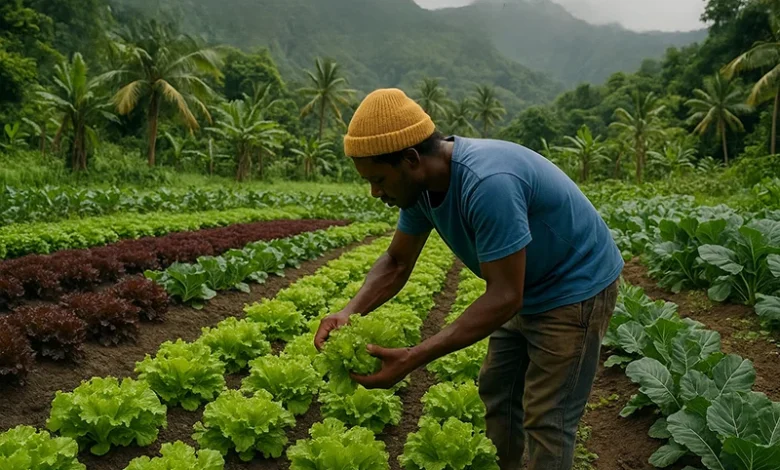Organic Farming in Dominica

Organic farming in Dominica is gaining momentum as the country capitalises on its fertile volcanic soil, tropical climate, abundant rainfall, and growing global demand for chemical-free produce. Although still emerging, the sector offers clear benefits in sustainability, export potential, and resilience, key traits for a small, climate-vulnerable Caribbean island.
Origins and Developments for Organic Farming in Dominica
The movement toward chemical-free farming became notable in the early 2000s. In 2009, a national workshop titled “Knowing & Growing” introduced organic practices to farmers and government officials . Led by the Ministry of Agriculture and supported by FAO, IICA, NGOs, and private sector partners, the workshop emphasized soil management, permaculture, and integrated pest control. At that time, no farms had official organic certification, though many followed organic methods .
Several smallholdings began conversion, particularly for crops like fruits, root vegetables, herbs, and spices. The establishment of the Dominica Organic Agriculture Movement (DOAM) in 2010 provided crucial momentum. DOAM advocates for organic standards, bans harmful chemicals like Gramoxone, and encourages educational and marketing initiatives. Today, some farms in areas like Bellevue Chopin, Calibishie, Castle Bruce, and La Plaine are either in conversion or operate under informal organic systems, with the goal of full certification.
Extent, Economics, and Consumer Interest
Unlike some Caribbean nations, Dominica lacks systemic national organic certification. Instead, Participatory Guarantee Systems (PGS) led by DOAM oversee small organic operations region-wide. No precise national acreage figures exist, but sector advocates estimate several hundred hectares now follow chemical-free practices. Consumer research from 2013 indicates strong local demand: Dominicans were willing to pay 17.5% more for organic produce and 12% more for locally grown items.
This premium willingness exists despite limited product availability in local markets; 45% of consumers reported difficulty locating organic produce . Nonetheless, DOAM and its partners see these figures as indicators of potential for an “Organic Island” identity and economic model.
Institutional Support and Stakeholders
A thriving organic sector depends on strong institutional frameworks and collaboration:
Key supporting institutions include:
- Ministry of Agriculture, Fisheries, Blue & Green Economy: Funds training, permits pilot organic farms, assists with agro-processing and soil tests.
- Dominica Organic Agriculture Movement (DOAM): Leads advocacy, standards, training workshops, composting systems, and local certification via PGS.
- Caribbean Agricultural Research and Development Institute (CARDI), FAO, and IICA: Provide testing, planning, and technical training.
- International partners including EU and GEF: Provide grants for organic pilot sites, certification systems, and marketing platforms.
- Local NGOs and private partners: Jungle Bay Resort and CATS have participated in organic supply chains and hosted farm tours.
Public-private workshops, such as the 2011 soil management training at Bellevue Chopin, Castle Bruce, and Calibishie, educated hundreds of farmers on composting and permaculture techniques.
Regional Trends and Environmental Impact
Dominica participates in regional programs on climate-smart agriculture and environmental resilience. Organic farming aligns with national goals to build climate resilience, reduce chemical dependence, and strengthen soil stability, especially important given hurricane vulnerabilities .
The country’s high biodiversity and protected watersheds benefit from chemical-free practices, which reduce runoff into key marine reserves like the Soufrière Scotts Head Marine Reserve, Salisbury Marine Reserve. By promoting agroforestry and crop rotation, farmers also help conserve endemic flora and fauna such as the Sisserou parrot.
Organic Certification and Policy Landscape
While Dominica does not yet have a national organic certification authority, advocacy for one continues. The Dominica Organic Agriculture Movement (DOAM) and its partners promote the use of Participatory Guarantee Systems (PGS), which allow for peer-reviewed inspections and community trust models. These systems are essential for smallholders who cannot afford costly international certifications from entities like USDA Organic or EU Organic. However, without a formal national policy or regulatory framework to legally recognize organic products, Dominican exports risk being categorized as “natural” rather than certified “organic.”
In 2010, government officials signaled interest in developing legal standards for organic agriculture. The National Export Strategy (NES) and Agricultural Investment Unit have since highlighted organic farming as a growth area, linking it with agri-processing and eco-tourism. While these frameworks exist on paper, there remains a gap between policy ambition and implementation on the ground.
Recent discussions have proposed integrating organic policy within Dominica’s National Resilience Development Strategy. This integration would support green energy, land conservation, and youth employment, connecting organic farming with national development.
Organic Crops, Yields, and Use
Organic farming in Dominica covers a wide range of produce:
- Bay leaf, turmeric, and ginger are key organically grown spices.
- Fruits like bananas, mangoes, guavas, and pineapples are often cultivated on permaculture-style farms.
- Root crops such as yams, sweet potatoes, and dasheen are traditionally grown without chemicals in rural districts.
- Vegetables include cabbage, lettuce, cucumbers, and eggplants in mixed-crop systems.
- Herbal plants such as lemongrass and basil are also gaining popularity in both the export and wellness sectors.
Yields vary. According to DOAM field reports, organically grown root crops yield around 60% of what conventional plots do, but show longer soil health and better resilience to climate impacts. Organic bananas, for example, have higher resistance to pests and fungal diseases, reducing loss even without synthetic inputs.
Most organic produce is consumed locally, sold via small farmers’ markets or eco-resorts. Export remains limited, although niche shipments of bay oil and turmeric have reached boutique health stores in Europe and Canada. The potential to expand exports through proper branding and certification is strong, especially in high-margin markets for Caribbean herbs and oils.
Regional Success Stories and Local Champions
In Bellevue Chopin, the Organic Farmers’ Group has emerged as a model for what can be achieved with education, community effort, and state support. They operate greenhouses, compost stations, and diversified organic plots. Their work has been featured in regional agricultural forums and they have hosted international development delegations.
In Castle Bruce, several family-run farms apply agroecological methods passed down through generations, adapting traditional bush farming to avoid chemicals. In Calibishie and La Plaine, permaculture enthusiasts and small eco-businesses have embraced organic methods, some hosting Airbnb-style farm stays that combine sustainability education with tourism.
Jungle Bay Resort and Rosalie Bay Eco Resort have also supported organic sourcing, collaborating with nearby farms to meet the standards expected by health-conscious travelers.
Challenges and Opportunities for Expansion
Despite clear advantages, several challenges inhibit sector growth:
- Access to organic-certified inputs like neem oil, compost inoculants, and bio-pesticides is limited. Most are imported and expensive.
- Storage and transport infrastructure is lacking, affecting shelf life and sales.
- Lack of a legal organic label hinders marketing and export competitiveness.
- Farmer training and extension services are underfunded, limiting uptake.
To overcome these, stakeholders suggest:
- Developing a National Organic Policy Framework, legally defining “organic” and supporting enforcement.
- Creating an Organic Farming Incentives Program to fund infrastructure like water tanks, irrigation, and protected cropping systems.
- Supporting organic farming in schools, integrating agriculture with environmental studies, and encouraging youth entrepreneurship.
- Investing in organic agro-processing for teas, oils, seasonings, and soaps.
- Launching a “Grown Naturally in Dominica” campaign targeting tourists and health food markets.
With regional support from CARICOM and the OECS, Dominica could serve as a testing ground for wider Caribbean organic policy alignment.
Cultural and Environmental Integration
Organic farming in Dominica resonates deeply with traditional practices of the Kalinago people and Maroon communities. These groups have long used chemical-free methods, cultivating cassava, maize, and medicinal plants in forest-integrated systems. These culturally rooted approaches to soil care, mixed cropping, and seed saving overlap with today’s global organic standards.
The environmental benefits are equally important. Chemical-free farming protects Dominica’s 365 rivers, delicate coral reefs, and UNESCO World Heritage sites. It reinforces the country’s green credentials, aligning with both climate resilience and sustainable tourism.
As Dominica develops a national food strategy and pushes toward food sovereignty, organic farming offers a realistic, culturally aligned, environmentally beneficial, and economically strategic path forward.
Looking Ahead
The potential for organic farming in Dominica is significant. With consumer willingness to pay premiums, fertile volcanic lands, and a proactive policy environment, the country could strengthen its position as a Caribbean leader in chemical-free exports.
To scale, the sector requires expanded certification, investment in processing and packaging facilities, and national policies to support producers and market access. Promoting agritourism, farm visits, eco-lodges, herbal workshops, can reinforce Dominica’s environmental image while supporting small-farm families.




